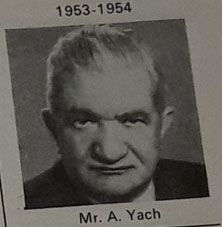As Sea Point was fashionable, the Atlantic seaboard Jewish community continued to grow, along with their membership. In his 1954 AGM report, president Aaron Yach stated that the old Talmud Torah building adjoining the synagogue had been converted into a synagogue hall for congregation functions, an office for the secretary and general administration, a board room and a rabbi’s office. Four years later the synagogue was enlarged to provide 400 more seats.

In 1959 they appointed Rabbi ES Rabinowitz BA Hons, a graduate from Mir Yeshiva, a kindly gentle peace maker with strong views and a sense of his importance. He was the brother of the Transvaal Chief Rabbi and was reported to have a very modern and realistic outlook and able to lecture in Hebrew, Yiddish and English (4.12.1958). A modern, realistic outlook was important to the modern, realistic, up and coming congregation. They invited Chief Rabbi Abrahams to induct Rabbi Rabinowitz, but, still sensitive about the primacy of his rank, he refused to attend if Rabbi Rabinowitz’s brother was there. The committee strongly deprecated Abrahams’ attitude - it looked as though nothing had changed in the intervening years (13.8.1959). Rabbi Rabinowitz however tried to make shalom and the committee agreed to rescind the motion to secede from the United Council (22.12.1959) yet the following year, just as with Rabbi Shrock, Rabbi Abrahams did not invite Rabbi Rabinowitz to join the Beth Din, which should have been automatic (2.8.1960). (He received his invitation to join twenty days later.)
Rabbi Rabinowitz thought the opening of the enlarged synagogue would be the ideal opportunity to cement good relations with the Chief Rabbi and suggested that he be invited to deliver the sermon on the occasion of the rededication – to which Abrahams graciously agreed (4.12.1962). The extensions were dedicated in January 1963 with a service conducted by Cantor Katzin and Rabbi Rabinowitz and presided over by president Ralph Lessem (no women in the choir). It was fitting that Archie Sacks as a founder member was given the opportunity to address the dedication. In 1934 he and Cantor Katzin had canvassed new members door to door. As vice chairman, he had watched the foundations being laid brick by brick and in 1952 he had laid the foundation stone of the Weizmann Synagogue Centre. He told the assembled crowd that when a congregation finds that its shul is too small, it is certainly making progress and he hoped the alteration would meet the needs of the congregation for many years.[i]
However when it came to the Reform Movement, Rabbi Rabinowitz had no intention of making shalom and was more hostile to the movement than Rabbi Shrock had been. When the Orthodox rabbis in Johannesburg came under criticism for imposing a boycott on any communal event that included Reform and had to retract, they left it up to the individual lay leaders and Rabbi Rabinowitz decided to step up to the plate. He used the opportunity of a 1963 Union of Jewish Women function to be addressed by Rabbi Sherman. His wife wrote to UJW refusing to attend and Rabbi Rabinowitz wrote to his congregants announcing that and telling them that the UJW, as a social and charitable organisation, had no right to invite a Reform minister to address them. “I am not going to tell my lady members that they must not go… but I really don’t think you should go” although he admitted that some women who had not intended to go were now going “out of perversity”. The UJW was denied the use of the old Shul where such talks were usually held, the event was moved to the Temple Hall and, wrote Rabbi Sherman, “Orthodox women were instructed not to attend the trefe lecture in the trefe hall. The result was an exceptionally large attendance.”[ii] The women did not share in the prejudices of their leaders and made their feeling clear by attending “out of perversity”.
